The article below by Roger Beck on Mithraism was originally published in the Encyclopedia Iranica on July 20, 2002. The article below discusses the cult of Mithra as it developed in the West, its origins, its features, and its probable connection with Mithra worship in Iran.
Kindly note that all of pictures displayed in the article below are from Kaveh Farrokh’s lectures at the University of British Columbia’s Continuing Studies Division, Stanford University’s WAIS 2006 Critical World Problems Conference Presentations on July 30-31, 2006 and Farrokh’s textbook Shadows in the Desert: Ancient Persia at War-Персы: Армия великих царей-سایههای صحرا–).
====================================================================
Mithraism, the cult of Mithra as it developed in the West, its origins, its features, and its probable connection with Mithra worship in Iran
For most of the twentieth century the major problem addressed by scholarship on both Roman Mithraism and the Iranian god Mithra was the question of continuity. Did Mithra-worship migrate from Iran to the Roman Empire in some institutional form or was Mithraism invented in the West (with a few Iranian trappings) as a new institution altogether? At the start of the twenty first century, this issue appears to be less central to the concerns of scholarship on Western Mithraism, but it remains important nevertheless, and obviously it must be the lens through which Mithraism is examined in this article. The first task, though, is to describe the Mithras cult as it did in fact develop in the West, and in so far as we can reconstruct it objectively from its material remains. Reconstruction is not easy, since no ancient literary works about Mithraism and no substantial sacred texts from Mithraism have survived.
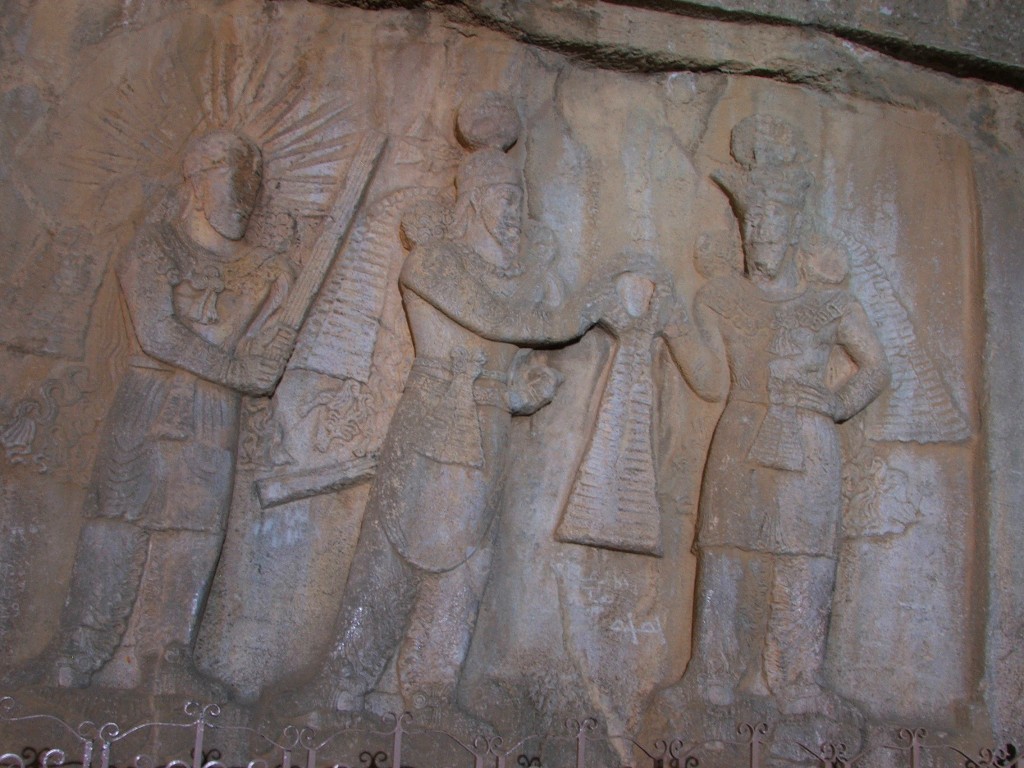 Investiture of Ardashir II (r. 379-383) (center) by the supreme God Ahuramazda (right) with Mithra (left) standing upon a lotus (Ghirshman, 1962 & Herrmann, 1977). Trampled beneath the feet of Ahura-Mazda and Ardashir II is an unidentified defeated enemy (possibly Roman Emperor Julian). Of interest are the emanating “Sun Rays” from the head of Mithras. Note the object being held by Mithras, which appears to be a barsum, or perhaps some sort of diadem or even a ceremonial broadsword, as Mithras appears to be engaged in some sort of “knighting” of Ardashir II as he receives the “Farr” (Divine Glory) diadem from Ahura-Mazda (Picture source: Shahyar Mahabadi, 2004).
Investiture of Ardashir II (r. 379-383) (center) by the supreme God Ahuramazda (right) with Mithra (left) standing upon a lotus (Ghirshman, 1962 & Herrmann, 1977). Trampled beneath the feet of Ahura-Mazda and Ardashir II is an unidentified defeated enemy (possibly Roman Emperor Julian). Of interest are the emanating “Sun Rays” from the head of Mithras. Note the object being held by Mithras, which appears to be a barsum, or perhaps some sort of diadem or even a ceremonial broadsword, as Mithras appears to be engaged in some sort of “knighting” of Ardashir II as he receives the “Farr” (Divine Glory) diadem from Ahura-Mazda (Picture source: Shahyar Mahabadi, 2004).
Western Mithraism described
The term “Mithraism” is of course a modern coinage. In antiquity the cult was known as “the mysteries of Mithras”; alternatively, as “the mysteries of the Persians.” The latter designation is significant. The Mithraists, who were manifestly not Persians in any ethnic sense, thought of themselves as cultic “Persians.” Moreover, whatever moderns might think, the ancient Roman Mithraists themselves were convinced that their cult was founded by none other than Zoroaster, who “dedicated to Mithras, the creator and father of all, a cave in the mountains bordering Persia,” an idyllic setting “abounding in flowers and springs of water” (Porphyry, On the Cave of the Nymphs 6).
Persia (or Parthia) in those times was Rome’s great rival and frequently at war with her. Nonetheless, there is no indication that this antagonism was ever problematic for the Mithraists socially or politically. Clearly, their cultic “Persian” identity, which they made no attempt to hide, was acceptable to the authorities and their fellow citizens.
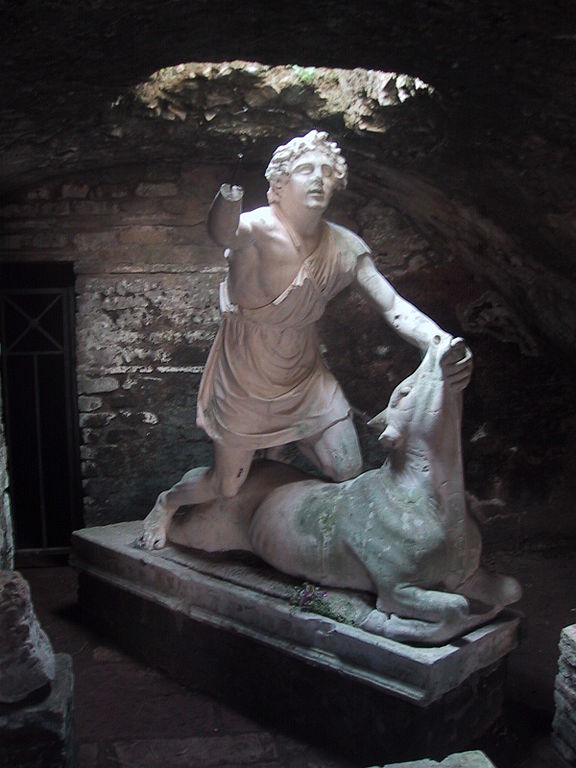 A Roman version of the statue of Mithras “Bringer of Light” in a Mithraic temple in Ostia, Italy (Consult, Hinnels, 1988, pp.83). Note the opening on the ceiling just above Mithras, allowing the sun rays to “illuminate” the god. Mithras in Iranian mythology is the bringer of light and justice as well as a manifestation of the eternal sun (Picture source: Public Domain).
A Roman version of the statue of Mithras “Bringer of Light” in a Mithraic temple in Ostia, Italy (Consult, Hinnels, 1988, pp.83). Note the opening on the ceiling just above Mithras, allowing the sun rays to “illuminate” the god. Mithras in Iranian mythology is the bringer of light and justice as well as a manifestation of the eternal sun (Picture source: Public Domain).
The socio-political acceptability of the Mithraists, despite their Perserie, can be explained largely by their social profile. They were the most conformist of men — and men indeed they were in the limited gender sense of the word, a factor which itself would add to their respectability or at least not detract from it (compare the charge against Christianity that it subverted the family by proselytizing the womenfolk). Mithraism drew its initiates disproportionately from the military, from the Empire’s petty bureaucracy, and from moderately successful freedmen (i.e. ex-slaves), in fact from theretainer classes, the very people who had a stake in the current sociopolitical dispensation. (On Mithraism’s social profile see Clauss 1992, Gordon 1972, Liebeschuetz 1994; Merkelbach 1984: pp. 153-88)
We noticed above that Mithraism’s original, archetypal sacred space was thought to be a cave. This perception, reported by an external source (the third-century CE philosopher Porphyry), is corroborated by internal data and the archaeological evidence. The Mithraists did indeed call their meeting places “caves,” whether they actually were or not. Natural caves were used where available; and where not, especially in urban settings (Rome, Ostia), a room or suite of rooms within some larger structure was used and sometimes decorated so as to resemble a natural cave. Mithraea (our modern term), like natural caves and unlike most constructed temples, had no elaborate or even recognizable exteriors. (On the structure of the mithraeum see White 1990: pp. 47-59.)
That Mithraists met in “caves” which were distinctively designed and furnished has had important consequences for the archaeological record and thus for our ability to reconstruct the cult. In addition to their cave-like appearance, mithraea were designed with raised platforms on either side of a central aisle to serve as banqueting couches for the cult meal (on which see below). They were also filled with much sacred art – sculptures (mostly in relief), altars, ritual pottery vessels, frescos, etc. – often with their dedications extant in whole or in part. There is no mistaking a mithraeum when archaeology brings it to light, and the chances are good that it will also divulge something about its membership. (On the furnishings and equipment of the mithraeum see Clauss 2000: 42-59, 114-30.)
The scattering of mithraea, thus identified across the Roman Empire, is perhaps more informative about the cult’s spread and social composition than are the material remains of any of its peers, early Christianity included. We have already looked at Mithraism’s social catchment. As for its spread, though represented virtually everywhere in the Roman empire, it was much stronger in the Latin speaking West than in the (predominantly) Greek-speaking East. It flourished in particular in the city of Rome and its port, Ostia, and along the Rhine-Danube frontier — exactly where one would expect from its social profile. (For maps, see Clauss 1992, province by province). Without doubt, an intentional concomitant of the “cave” was the small size of Mithraic groups or cells. The upper limit to the number of persons who can feast intimately on side platforms in a cave or a cave-like inner room is soon reached. Mithraism, then, was a religion of small communities. These communities, moreover, were self-sufficient. There is not a shred of evidence for any co-ordinating, let alone regulating, higher authority. There were no Mithraic bishops; the contrast with contemporaneous Christianity, or for that matter with the contemporaneous state Zoroastrianism of Kerdir, could not be more extreme. As social institutions the Mithraic communities are classed among those groups termed (by moderns) “voluntary associations.” Not all voluntary associations served religious ends. Some were analogous to trade guilds; perhaps the most common form was the burial society, clubs which could assure their members funerals in a more ample and sociable style than they could individually command. In the religious sphere, it is the voluntary nature of membership that distinguishes these associations from other religious enterprises. One chose to be initiated into the Mysteries of Mithras, whereas one belonged (normally in an entirely passive way) to the public cults of city and empire simply by virtue of belonging at one level or another, from emperor to slave, to those socio-political units: to the public cults you could no more opt in than you could opt out. It follows that ancient mystery cults, Mithraism included, were non-exclusive: as a Mithraist, you would expect, and be expected, to continue your participation in the public cults (On Mithraism as a voluntary association, see Beck 1996.) The “Mysteries of Mithras,” to return to their ancient name, were one of a number of ancient religious “mysteries.” A “mystery,” in Greek, is something into which one is initiated. Modern connotations of the “mysterious” or the “mystical” are irrelevant, and although most ancient mysteries were in fact secret, secrecy was not always a requirement. Not all mysteries were transmitted in and by voluntary associations, and not all voluntary religious associations transmitted rites of initiation as their sole or even principal business. Indeed, Mithraism appears to be the only substantial pagan cult of which it can be said that initiation into its mysteries was both the necessary and the sufficient condition of membership. (On ancient mystery cults, see Burkert 1987.) Organizationally, the Mithraic groups functioned much as other voluntary associations, but in addition there was an esoteric hierarchy of seven grades. Scholars disagree about the extent of this hierarchy. Was it universal, or normative, or a refinement limited to the relatively few mithraea where it is directly attested? Was it a priesthood? Most scholars would agree that it was not ubiquitous in the sense of being a requirement for all mithraea; also that the initiate of the highest grade, the Father, excercised leadership in all aspects of the mithraeum’s sacred business, and that virtually all mithraea would have had at least one Father (two are attested in some mithraea), regardless of the presence or absence of other grades. (On the grades see Clauss 2000: pp. 131-40; contra: Gordon 1994: pp. 465-7; on their esoteric significance, see Gordon 1980a: pp. 19-99.) Into what was a Mithraist initiated? What, in other words, constituted the sacred business of a mithraeum? Scholarship is in broad agreement that the principal act was the cult meal, celebrated both as an actual feast by the initiates reclining opposite each other on the platforms which served as banqueting couches and as a ritual re-enactment of the feast of Mithras and the Sun god celebrated on the hide of a bull freshly slain by Mithras. (On the cult meal, see Kane 1975.) That there was another purpose to the Mithraic mysteries and a corresponding ritual is attested in the same passage from Porphyry (On the Cave of the Nymphs 6), already cited above, which tells us that the Mithraists called their sacred places “caves” — and why. The intent of the Mithraists was to “induct the initiate into a mystery of the descent of souls and their exit back out again.” It was for this ritual purpose (which has been generally misconstrued as a didactic purpose) that the Mithraists made their sacred space cave-like, for the cave is “the symbol of the universe,” into which the soul enters for mortal existence and quits for immortality. Accordingly, Porphyry continues, the mithraeum is designed and furnished with “cosmic symbols appropriately arranged” so as to be an authentic microcosm. (On this ritual and the corresponding design function of the mithraeum, see Beck 2000: pp. 154-65; this article also describes and explicates the two previously unknown rituals depicted on opposite sides of the cult vessel discussed.) For other initiatory rites we depend primarily on the fresco scenes in the mithraeum at S. Maria Capua Vetere. These depict usually a triad of figures: the initiates, small, naked, humiliated; and two initiators, one behind and the other in front of the initiates, manipulating the instruments of initiations. (For illustrations, see Vermaseren 1971: Plates 21-8.) Mithraism was an astral religion. The perceivable heavens and the celestial bodies (sun, moon, the other five planets, stars) all played a part in the mysteries — the sun necessarily a very large part, since Mithras himself was the Sun god (see below). Astral symbolism (e.g. representations of the zodiac) was liberally deployed on the sculpted and painted monuments and in the design of the mithraeum in order to render it a true likeness of the cosmos “for induction into the mystery of the descent of souls and their exit back out again” (see above). Furthermore, each of the seven grades of the hierarchy was “under the tutelage of” one of the seven planets. Finally, in the principal cult icon, the representation of Mithras as bull-killer (see below), there is a remarkable correspondence between several of the standard elements of the composition and the constellations of a particular tract of the heavens (e.g. the raven and the constellation Corvus). The astral symbolism incorporated into the mysteries stems of course from the ancient Graeco-Roman construction of the heavens and their denizens in the astronomy/astrology of the times. On the intent of the symbolism there is no scholarly consensus. Indeed, several influential scholars have treated it as superficial decoration without any profound intent at all. That is mistaken. Granted, it is difficult to prove a negative. Nevertheless, the arguments against deep intent have so far merely re-asserted their premise as conclusion: astral symbolism is without deep intent because it is superficial. Only Franz Cumont, the founder of modern Mithraic studies, avoided this petitio principii. He did so by postulating the imposition of an astrological layer by the Chaldeans and by “Hellenized Magi” during the transmission of Iranian Mithra-worship from Iran to the West (Cumont 1903: pp. 119-30). (For arguments for deep intent in the astral symbolism, see Merkelbach 1984: pp. 75-133, 193-244; Beck 1988; Beck 1994; Beck 2000: pp. 154-65; Ulansey 1989; Jacobs 1999. As superficial imagery, (e.g.) Clauss 2000: pp. 87, 89, 97.) Roman Mithras Since the function of its mysteries was to relate the initiate to Mithras, the cult was of course centred entirely on the person of the god. His cult title was “Deus Sol Invictus Mithras”: thus, he was “god,” he was “the Sun,” he was “unconquered,” he was “Mithras.” To his identity as the Sun and to his invincibility must be added his Persian-ness, a “fact” known to outsiders as well as to his initiates. Iconographically, he is depicted in exotic non-Roman, specifically oriental garb: trousers and the “Persian” cap. Gods have their personal histories. The story of Mithras survives not in written form derived from an oral narrative — if such there ever was, it has disappeared without trace — but as scenes preserved on what are collectively termed “the monuments,” for the most part as relief sculpture on icons, altars, etcetera, but also as statuary and in fresco on the walls of mithraea. In the frescos and on the great complex reliefs (the latter mostly from the Rhine and Danube frontier provinces) a selection of side-scenes representing various episodes surrounds the central scene, the god’s sacrificial killing of a bull. More often this “tauroctony” is a self-contained icon, and from its privileged location at the head of the central aisle we know that it was the cult’s principal icon; consequently, that the bull-killing was the main event in the Mithras myth. (The fundamental illustrated catalogue of Mithraic monuments is Vermaseren 1956-60. Merkelback 1984 and Clauss 2000 are also exceptionally well illustrated. On the iconography of Mithras, see Vollkommer 1992. On the myth of Mithras as inferred from the iconography, see Cumont 1903: pp. 104-49; Vermaseren 1960: pp. 56-88; Clauss 2000: pp. 62-101.) Some of the larger reliefs could be swiveled so as to display on their reverse the scene of Sol and Mithras feasting on the hide of the bull. The gods’ banquet, then, is the outcome of the sacrifice, and since it is replicated in the cult meal of the initiates (see above), it must be supposed that the mythic sacrifice performed by Mithras is the salvafic cause of whatever benefits accrue to his mortal initiates in replicating the banquet of the two gods. The side-scenes are numerous, and they represent many different episodes in the myth, e.g. the pursuit and capture of the bull, the ascent of Mithras in the Sun’s chariot, as well as occasional episodes which, as far as one can tell, do not include or concern Mithras at all. Moreover, there is no standard order or canon of scenes: only the internal logic of the narrative orders the episodes (e.g., bull-killing precedes banquet, because the bull’s hide serves as couch cover for the banqueters). (On the composition of complex monuments, see Gordon 1980b; Beck 1984: pp. 2075-8) In addition to the bull-killing and the banquet, the scene of Mithras’ birth is manifestly important. He is shown rising upright from a rock, not as a baby but in the prime of youth, with extended arms holding torch and sword. He has, it seems, no father. It would be wrong to say that he has no mother, for the rock itself, identified explicitly as Petra Genetrix (“the rock that gives birth”) is his mother. Since the bull-killing was so obviously the god’s principal act, and since the icon which represents it was so clearly the cult’s primary locus of meaning, the scene as regularly represented (with remarkably few variations from the norm) must be described. At the mouth of a cave, Mithras straddles the bull, plunging a dagger into its heart. A dog and a snake dart up at the blood flowing from the wound. A scorpion fastens on the bull’s genitals, and a raven perches on the god’s billowing mantle. Miraculously, the tail of the dying bull has metamorphosed into an ear of wheat. On either side of the scene the twin gods Cautes and Cautopates are posed, the former holding a raised torch, the latter a lowered torch. Above and to the left is the Sun god, above and to the right the Moon goddess. Frequently in tauroctonies from the Rhine and Danube areas, a lion and a two-handled cup are added to the scene. Finding the “meaning” of the scene has been, perhaps to excess, the Great Game of Roman Mithraic hermeneutics. Yet a simple narrative solution, that the bull-killing is just an episode — albeit the principal episode — in the Mithras myth lacks plausibility because of the unusual and ill-assorted assemblage of beings which surround the sacrificing god. As an event, even a supernatural event, in a story it strains one’s sense of narrative realism. So while the tauroctony does indeed represent an episode in a story, it represents, it evokes, it intimates something more; and it does so by means of the elements of the composition functioning as symbols, collectively or individually. Interpretations which look eastwards to Iran will be discussed in the next section. The other important modern interpretation looks upwards to the heavens and the notable correspondence between elements of the composition and the ancient constellations (see above, on Mithraism as an astral religion). The shortcoming of interpretations of this latter type is that they have tended to treat the tauroctony rather simplistically as a star chart from which one can decipher the celestial identity of the god as this or that constellation. (For a survey of interpretations of the tauroctony, see Beck 1984: pp. 2080-3; Martin 1994. For celestial interpretations, see Insler 1978; Ulansey 1989; Beck 1994; Jakobs 1999; Weiss 1998. For an important redirection of interpretation (the tauroctony as “cult scene” and “depiction of ritual sacrifice”), see Martin 1994. On the tauroctony in the context of Roman imperial art, see Zwirn 1989. Iranizing interpretations will be referenced in the next section.) Emperor Julian is killed during his failed invasion of Sassanian Persia in June 26, 363 CE. Above is a recreation of Sassanian Persia’s elite cavalry, the Savaran, and combat elephants as they would have appeared during Julian’s failed invasion. Note the rider in Mithraic attire bearing an unknown Sassanian 3-pronged symbol (Picture source: Farrokh, Plate D, -اسواران ساسانی- Elite Sassanian cavalry, 2005). As one would expect in a relatively elaborate Roman cult, Mithras does not lack for divine company. The Graeco-Roman Sun god Helios/Sol has already been mentioned — that Mithras both is and is not the Sun, depending on context, is one of those paradoxes which religions take in their stride — as have the planetary gods. Various of the Olympian gods also play a role, though a minor and marginal one. Finally, there are three esoteric deities, two of whom are the twins Cautes and Cautopates, already mentioned as witnesses to the bull-killing. In appearance they are clones of Mithras, and they represent through their primary attributes of the raised and lowered torches paired opposites in nature and in the heavens (e.g. rising sun and setting sun, flanking Mithras as the midday sun). Within the mystery, they symbolize and, as agents, control the entry of the soul downward into mortality (Cautopates) and its exit upwards into immortality (Cautes). (On this pair of deities, see Hinnells 1976; Beck 1984: pp. 2084-6). The third esoteric deity is the enigmatic “lion-headed god.” Since his identification is bound up with the question of Mithraism’s eastern origins, he will be discussed in the next section. From Iranian Mithra to Roman Mithras: Continuity versus re-invention That Roman Mithras was a Persian god in more than just the perception and self-definition of his Roman initiates is indisputable. To say that he was “the same” god, or that he “came from” Iran is equally true, though it begs as many questions as it appears to answer. Did he emigrate together with his cult? Was institutionalized Mithra-worship transmitted from East to West? Likewise the Mithra myth(s) and the concepts of the god, his powers, and his functions? Was he “the same” god in that strong sense? Or was he re-invented in the West, perhaps by those with some knowledge of the East, as a new god for new mysteries in a new type of cult association appropriate to the different social and cultural environment of the Roman Empire? Was he “the same” merely in the weaker sense that he was re-outfitted with Iranian trappings sufficient to authenticate him as “Persian” in his new context? Two statements at least may be made with some confidence about the century-long scholarly controversy over these questions: first, that at the beginning of the third millennium there is still no consensus; secondly, that in the last three decades the balance of opinion has shifted, rightly or wrongly, in favor of re-invention over continuity. What one might call the “default” transmission scenario (at least for the first two thirds of the twentieth century) was propounded by the founder of modern Mithraic studies, Franz Cumont, in 1899 (see also Cumont 1903). For Cumont, Mithraism in the West was Romanized Mazdaism, thus still at its core a Persian religion, though one which had undergone extensive metamorphoses in its passage first through Chaldaea, where it acquired its astrological overlay and the syncretic assimilation to Mithra of the Babylonian Sun god Šamaš; and secondly through Anatolia and the culture of the Magusaeans, the Hellenized Magi of the Iranian diaspora (on whom see Bidez and Cumont 1938, Beck 1991), where it acquired a Stoic cosmology of sorts, especially in its eschatology (on which see Cumont 1931, Beck 1995). In assessing Cumont’s and later scholars’ arguments for transmission, one must keep in mind the two types of evidence deployed: first, common traits, i.e. similarity of the features of Mithras and Mithras-worship in the West with those of Mithra and Mithra-worship in the East to the point that coincidental re-invention in the West would cease to be a credible hypothesis; secondly, evidence of actual intermediate stages in the East-West transfer. We begin here with the latter. It is the stronger of the two types of evidence, but in volume the more meager. The evidence, and some of the inferences drawn from them, are as follows. 1) Plutarch (late first century CE), in Life of Pompey 24, states that the Cilician pirates who were vanquished by Pompey in the mid 60’s BCE “celebrated certain secret rites of initiation (Greek teletas), of which those of Mithras have survived up to now” (or “as far as here,” i.e. Rome: his Greek phrase mechri deuro is ambiguous). It is possible, but not certain, that these ‘initiations’ were a prototype of the Roman mysteries of Mithras. (For contra, see Francis 1975.). 2) Mithras — moreover, a Mithras who was identified with the Greek Sun god Helios — was one of the deities of the syncretic Graeco-Iranian royal cult founded by Antiochus I (q.v.), king of the small but prosperous buffer state of Commagene (q.v.) in the mid first century BCE. It is improbable in the extreme that this cult played no part in the transmission of Mithra-worship westwards, although nothing about it compels one to accept that it was a prototype of the Roman mysteries. So far, nothing about the recently discovered mithraeum at Doliche (see Schütte-Maischatz and Winter 2000) suggests that its cult relief is other than a product of second or third century CE Mithraism. (On the royal cult of Commagene and the role of Mithras therein, see Boyce 1991: pp. 309-51; Dörner 1975; 1978; Duchesne-Guillemin 1978a; Jacobs 2000; Merkelbach 1984: pp. 50-72; Schwertheim 1979; Wagner 1983; 2000; 2000a; Waldmann 1991. For a scenario of transmission incorporating the Commagenian royal cult and the royal family of subsequent generations, see Beck 1998.) 3) While archaeology has (as yet) unearthed no evidence in Anatolia for an intermediate form of Mithras-worship which is unambiguously the precursor of the Roman mystery cult, several atypical monuments and inscriptions from this area (as well as from Crimea to the north across the Black Sea) make it entirely plausible that such intermediate forms may well have existed, and hence that Anatolia in the larger sense, not just Commagene, played some part in Mithraism’s westward transmission. Cumont’s Magusaeans (see above), though real enough in their own right, are no longer regarded as the conduit for Mithraism. (The Cumontian scenario was first challenged by Wikander 1951; subsequently by Gordon 1975; Beck 1991: pp. 539-50.) There are however other plausible scenarios, some (e.g. Colpe 1975: pp. 390-9; Boyce 1991: pp. 468-90) involving the Iranian diaspora in Anatolia. (On Mithras-worship in Anatolia and its atypical remains, and for theories of transmission through Anatolia, see Beck 1984: pp. 2018-19, 2071-3; Boyce 1991: pp. 468-90; Colpe 1975: pp. 390-9; Cumont: 1939; Gordon 1978: pp. 159-64, 169-71; Gordon 1994: pp. 469-71; Schwertheim 1979; Will 1955: pp. 144-69; Will 1978: pp. 527-8.) 4) In Syria it is the absence of data on any intermediary form of Mithraism that is remarkable (a Chestertonian “dog which did not bark”). With the single exception of the recently discovered Huwarti mithraeum, the few actual mithraea and the monuments lacking known provenance which have been recovered there exemplify either the norms of western Mithraism or minor variations on those norms. The Huwarti mithraeum, moreover, dates to the final decades of the fourth century CE. Accordingly, it speaks of the local redefinition of a religion in its final years, not of “a road not taken” in its formative years. Mithraism in Syria was not a transitional phase intermediate between East and West, but a back-formation from the West in the East. Even the mithraeum at Dura Europos on the Euphrates, at the easternmost margins of the Roman empire, proved no exception. Arguably, its only significant Iranian feature is the fresco of a pair of enthroned elders in local ceremonial garb with scrolls and canes. These Cumont identified as Zoroaster and Ostanes; but they could as well be the Fathers of this particular Mithraic community at the time. (On Mithraism in Syria, see Roll 1977; Downey 1978; also the proceedings of the Colloquium “Mithra en Syrie,” Lyon, November 2000, forthcoming in Topoi, which will include discussion of the Huwarti mithraeum. On the Dura mithraeum, see Cumont 1975; Beck 1984: pp. 214-17.) 5) In a description of Zoroastrian dualism which he inserted into his important essay On Isis and Isiris (46-7), Plutarch speaks of Mithras as “in the middle” (meson) between the good Horomazes and the evil Areimanius, adding “and this is why the Persians call the Mediator Mithras.” This, it is generally agreed, does not ascribe moral neutrality to Mithras; rather he is the referee, arbiter, or judge between the two warring parties. However, even if the clause is more than Plutarch’s own gloss, it speaks not of transitional Mithraism but of Mithra in the context of a collateral form of Zoroastrianism known to that learned Greek author. (On the passage and its interpretation, see de Jong 1997: pp. 171-7; on Mithra as judge, see Shaked 1980.) 6) The final piece of evidence which speaks directly to the question of transfer is the report of the state visit of Tiridates of Armenia to Rome to be crowned by Nero. At the coronation Tiridates declared that he had come “in order to revere you [Nero] as Mithras” (Dio Cassius 63.5.2). In the same visit, according to Pliny (Natural History 30.1.6), Tiridates “initiated him [Nero] into magical feasts” (magicis cenis). Since Tiridates had brought Magi in his retinue, it is likely that the “feasts” were “Magian” rather than “magical” in the contemporary Roman sense. In the Cumontian scenario this episode cannot mark the definitive moment of transfer, for Mithraism in that scenario was already established in Rome, albeit on a scale too small to have left any trace in the historical or archaeological record. Nevertheless, it could have been a spur to Mithraism’s emergence on to the larger stage of popular appeal. Perhaps, too, it affected in some way the development of Mithraism’s central rite, the cult meal (see above). (On the episode and its implications for Mithraism, see Cumont 1933; for an alternative scenario which places the cult’s institution after this episode, Beck 2002.) When we turn to the much ampler dossier of similarities between Iranian Mithra-worship and the Mithras-worship of the Roman mystery cult, we must keep in mind that arguments for continuity based on these similarities all imply that the similarities are so systematic and so detailed that a non-causal relationship is untenable. Necessarily, therefore, they entail some transfer scenario, whether or not they expound one explicitly. Arguments for Mithraism’s invention or re-invention in the West, on the contrary, imply that the similarities are too slight and too haphazard to warrant a causal explanation. Accordingly, no transfer scenario is required beyond a certain awareness of “oriental” wisdom among Mithraism’s founders. Of the latter position there is a strong and a weak form. The strong form, having noted the undeniable similarities, then describes the cult, its origins, and its early development entirely in terms of the socio-religious culture(s) of the Roman empire. A typical proponent of this strong form is M. Clauss (2000: pp. 3-8, 21-2), who locates the cult’s origins and point of departure firmly in late first-century CE Rome. Not because it is wrong, but solely because it is not germane to the mandate of Encyclopaedia Iranica, there is no need to explore this version of Mithraic origins further. Discontinuity’s weaker form of argument postulates re-invention among and for the denizens of the Roman empire (or certain sections thereof), but re-invention by a person or persons of some familiarity with Iranian religion in a form current on its western margins in the first century CE. Merkelbach (1984: pp. 75-7), expanding on a suggestion of M.P. Nilsson, proposes such a founder from eastern Anatolia, working in court circles in Rome. So does Beck 1998, with special focus on the dynasty of Commagene (see above). Jakobs 1999 proposes a similar scenario. We may now turn finally to the similarities between western Mithraism and Iranian Mithra-worship and to the scholarship which has argued, in the Cumontian tradition, for significant continuity. (The scholarship up to the time of writing is surveyed in Beck 1984: pp. 2059-75). Predictably, the similarities mostly cluster around the person of Mithra/Mithras (remarkably, the second two of the three given here are not so much similarities as inversions): (1) Roman Mithras was identified with the Sun (see above); Iranian Mithra was a god of the dawn light. When and how the Iranian god became the Sun, as eventually he did, has been much debated (Lommel 1962; Gershevitch 1975, Gnoli 1979, Lincoln 1982; see above on the solar Mithras of Commagene; see below on M. Weiss’s theory of the non-solarity of Mithra/Mithras both East and West). (2) Iranian Mithra was a god of cattle and pastures; Roman Mithras was a “cattle-thief” (explicitly so called, e.g. Porphyry, On the Cave of the Nymphs 40), all the more outrageous an inversion because Iranian Mithra was a god of righteousness whose very name means “contract.” (3) Most importantly, Roman Mithras, as his mightiest and most beneficent deed, sacrifices a bull (see above); while Iranian Mithra was not himself a bull-killer, the act of bull-killing does figure prominently in the Zoroastrian cosmological narratives. In the first instance it was an act of evil: Ahriman slew the primal Bull of creation. However, the destructive act was turned to good, when from the bull’s sperm, purified in the moon, sprang the domestic animals. The second and future event is entirely beneficial. A savior figure, Sošyant, will sacrifice a bull from whose fat, mixed with hôm, the drink of corporal immortality will be prepared. The bull-killing of Mithras can be construed as the Roman translation of either — or indeed of both — of the Iranian cosmogonic and eschatological myths. Certain of the compositional details of the tauroctony resonate with the former: the bull’s tail metamorphosed into the wheat ear, the scorpion at the bull’s genitals, the presence of the Moon as well as the Sun. The Pahlavi texts, notably the Bundahišn, which carry the Zoroastrian cosmological accounts are several centuries later than the Roman-era artifacts, i.e. the tauroctonies, which carry the western representation of the bull-killing. Accordingly, Iranizing interpretations of the tauroctony (for a survey of these, see Hinnells 1975a; Beck 1984: pp. 2068-9, 2080-1) imply one of two scenarios, whether or not they make the choice explicitly. Either those who constructed the western Mysteries consciously altered the Zoroastrian cosmological myths which were already current in the form later attested by the Pahlavi sources; or they took over and reproduced a collateral, non-Zoroastrian form of Iranian religion (Mazdaist or otherwise), current at the time but subsequently extinguished without trace, in which Mithra was the bull-killer. A version of the latter argues that what the western mysteries adopted was an offshoot of the Vedic tradition in which Mitra reluctantly slays the Soma (= Iranian Haoma) god (Lommel 1949). More persuasive, perhaps, than postulating a precise Iranian/Vedic genealogy for the tauroctonous Mithras is the argument that the Mithraic bull-killing, both as concept and as image, reflects a peculiarly Iranian ideology of sacrifice as a creative act undertaken by god, not man (Hinnells 1975a; Turcan 1981; Turcan 2000: pp. 102-5) — with the implication, presumably, that it is so because those who first imagined the icon in the West had at least something of that ideology in mind. (On a fascinating continuity into modern Zoroastrianism in Iran, see Boyce 1975.) There is a further problem that complicates all transmission scenarios: how to accommodate the twin deities Cautes and Cautopates and the lion-headed god (both mentioned above). Are they part of the theological baggage transferred from Iran? The names of the twins may well be of Iranian origin (see Schwartz 1975; contra: Schmeja 1975: p. 20), for Roman Mithraism did in fact occasionally borrow genuinely Iranian words (see Gray 1926: pp. 89-99; Schmeja 1975), notably nama (= “hail!”) and nabarzes (precise etymology disputed, see Schwartz 1975: pp. 422-3). That, however, does not extend to their functions in the theology of the western mysteries, which can be fully accounted for in solely western terms (Beck 1984: pp. 2084-6). The lion-headed god is more problematic, partly because his eventual place in the western cult’s theology is as opaque as his provenance. (On the extant exemplars and their iconography, see Hinnells 1975b; on the various interpretations and identifications, see Beck 1984: pp. 2086-9). Of the several identities proposed for the lion-headed god, two link him unambiguously with Iran. The first, propounded by Cumont (1899: p. 78; 1903: pp. 107-10), identifies him as Zurvān, the god of infinite Time and the father and arbiter between the good Ohrmazd and the evil Ahriman. This would of course make Roman Mithraism the descendant of a Zurvanite branch of Mazdaism. Around this Iranian core accumulated the personae and attributes of various Egyptian and Hellenistic Greek deities, for the most part gods of Time (Pettazzoni 1954). The second Iranian identity, first proposed by I.F. Legge (1912-15), is Ahriman — an outrageous choice were it not that the name Arimanius is attested in Mithraic epigraphy, although never in a context which makes it more than a possibility that the Mithraic lion-headed god was Ahriman (Duchesne-Guillemin 1955; idem, 1958-62; on discussions of the epigraphy and the relevant monuments, see Beck 1984: pp. 2034-5). If the Mithraic lion-headed god was indeed a descendant of the Iranian Ahriman, there is no need to assume, for that reason alone, that he retained an exclusively negative and evil nature, or that, in consequence, the Roman Mithraists were devil-worshippers on the side. It would be impractical in a work of this scope to discuss every minute similarity which has been demonstrated or claimed between western Mithraism and Iranian Mithra-worship. (For a fuller summary, see Beck 1984: pp. 2056-89; for arguments stressing dissimilarities and discontinuities, see Colpe 1975; Drijvers 1978.) The time has come to review the principal scholarship which has argued for transmission and continuity based on the postulated similarities. The Cumontian “default” scenario has already been described. Of the post-Cumontian scenarios, three argue for continuity in the strongest terms. A.D.H. Bivar (1998, and earlier studies mentioned there) argues that western Mithraism was but one of several manifestations of Mithra-worship current in antiquity across a wide swathe of Asia and Europe. L.A. Campbell (1968) argues in the Cumontian tradition that western Mithraism replicated, through a thin disguise and with certain Graeco-Roman admixtures, a sometimes extraordinarily detailed and learned form of Zoroastrian Mazdaism. A continuity as thoroughgoing, though not quite so systematic ideologically, was proposed in several studies by G. Widengren (1965: pp. 222-32; 1966; 1980). Starting from the dissimilarities between Roman Mithraism and Zoroastrian Mazdaism, the most obvious of which are of course the different supreme deities in the two systems and the different agents and intents of the bull-killing (discussed above), scholarship on Iranian Mithra-worship has also looked for and found closer analogies with Mithraism in pre-Zoroastrian and non-Zoroastrian Iranian religion — and beyond that in Vedic religion. The strength of hypotheses based on the analogies with pre-/non-Zoroastrian systems is that they do not need to postulate a deliberate adaptation of Zoroastrianism into western Mithraism; their weakness is that they have to postulate instead the persistence in western Iran of an early collateral Indo-European form of Mithra-worship, ready for easy translation into Roman Mithraism, for which there is no direct evidence. P.G. Kreyenbroek (1994), by comparing cosmogonies (Mithraic similar to non/pre-Zoroastrian; both of these dissimilar to Zoroastrian), has advanced perhaps the most persuasive transmission scenario of this type to date. M. Weiss (1996, 1998) argues that Roman Mithras continues a very early Iranian and Vedic conception of Mithra/Mitra as the Nachthimmel, the starry heavens, an hypothesis entailing the awkward conception of a Mithras who is wholly distinct from the Sun god. Lastly, there are certain works specifically on Iranian religion, in addition to those of Widengren (1960, 1965) already mentioned, which discuss aspects of western Mithras or Mithraism in terms which assert or imply a fair measure of continuity: Gray 1926: pp. 89-99; Gershevitch 1959: pp. 61-72; Zaehner 1961: pp. 97-144; Duchesne-Guillemin 1962: pp. 248-57. Bibliography: Bibliographic note: The foundational study of Roman Mithraism is Cumont 1899 and Cumont 1903. Short general studies: Vermaseren 1963; Turcan 2000; Clauss 2000. Merkelbach 1984 is a fuller comprehensive study. On Mithraism as a mystery cult among other mysteries, Bianchi 1979a; Sfameni Gasparro 1979. There are four volumes of conference papers devoted both to Iranian Mithra and to Roman Mithras and Mithraism: Hinnells 1975; Duchesne-Guillemin 1978; Bianchi 1979; Hinnells 1994. Bibliographic survey: Beck 1984; Gordon in Clauss 2000: pp. 183-90. (abbreviation, JMS = Journal of Mithraic Studies). R.L. Beck, “Mithraism since Franz Cumont,” Aufstieg und Niedergang der römischen Welt, II.17.4, 1984, pp. 2002-115. Idem, Planetary Gods and Planetary Orders in the Mysteries of Mithras, Leiden, 1988. Idem, “Thus Spake Not Zarathuštra: Zoroastrian Pseudepigrapha of the Greco-Roman World,” in Boyce and Grenet 1991 (see below), pp. 491-565. Idem “In the Place of the Lion: Mithras in the Tauroctony,” in Hinnells 1994 (see below), pp. 29-50. Idem, “Dio Cocceianus,” Encyclopaedia Iranica, Vol. 7, 1995, p. 421. Idem, “The Mysteries of Mithras,” in J.S. Kloppenborg and S.G. Wilson (eds), Voluntary Associations in the Ancient World, London, 1996, pp. 176-85. Idem, “The Mysteries of Mithras: A new account of their genesis,” Journal of Roman Studies 88, 1998, pp. 115-28. Idem, “Ritual, Myth, Doctrine, and Initiation in the Mysteries of Mithras: New evidence from a cult vessel,” JRS 90, 2000, pp. 145-80. Idem, “History into Fiction: The metamorphoses of the Mithras myths,” Ancient Narrative 1, 2001-02, pp. 283-300. U. Bianchi ed., Mysteria Mithrae, Leiden, 1979. Bianchi 1979a “The Religio-Historical Question of the Mysteries of Mithra,” in Bianchi ed. 1979, pp. 3-60. J. Bidez and F. Cumont, Les Mages hellénisés, 2 vols, Paris, 1938 (repr. 1973). A.D.H. Bivar, The Personalities of Mithra in Archaeology and Literature, New York, 1998. M. Boyce, “Mihragān among the Irani Zoroastrians,” in Hinnells ed. 1975, pp. 106-18. M. Boyce and F. Grenet, A History of Zoroastrianism , Vol. 3, Leiden, 1991. W. Burkert, Ancient Mystery Cults, Cambridge MA, 1987. L.A. Campbell, Mithraic Iconography and Ideology, Leiden, 1968. M. Clauss, Cultores Mithrae: Die Anhängerschaft des Mithras-Kultes, Stuttgart, 1992. Idem, The Roman Cult of Mithras, trans. R.L. Gordon, Edinburgh and New York, 2000. C. Colpe, “Mithra-Verehrung, Mithras-Kult und die Existenz iranischer Mysterien,” in Hinnells ed. 1975, pp. 378-405. F. Cumont, Textes et monuments figurés relatifs aux mystères de Mithra, Vol. 1, Brussels, 1899. Idem, The Mysteries of Mithra, trans. T.J. McCormack, London, 1903 (repr. New York, 1956). Idem, “La fin du monde selon les mages occidentaux,” Revue de l’Histoire des Religions, 103, 1931, pp. 29-96. Idem, “L’iniziazione di Nerone da parte di Tiridate d’Armenia,” Rivista di Filologia, NS 11, 1933, pp. 145-54. Idem, “Mithra en Asie Mineure,” in Anatolian Studies in Honour of W.H. Buckler, Manchester, 1939, pp. 67-76. Idem, “The Dura Mithraeum,” ed. and trans. E.D. Francis, in Hinnells ed. 1975, pp. 151-214. A. de Jong, Traditions of the Magi: Zoroastrianism in Greek and Latin Literature, Leiden, 1997. F.K. Dörner, Kommagene, Antike Welt Sondernummer 1975. Idem, “Mithras in Kommagene,” in Duchesne-Guillemin, ed. 1978 (see below), pp. 123-33. S.B. Downey, “Syrian Images of Mithras Tauroctonos,” in Duchesne-Guillemin ed. 1978, pp. 135-49. H.J.W. Drijvers, “Mithra at Hatra?” in Duchesne-Guillemin, ed., 1978, pp. 151-86. J. Duchesne-Guillemin, “Ahriman et le dieu suprême dans les mystères de Mithra,” Numen 2, 1955, pp. 190-5. Idem, “Aion et le léontocéphalique, Mithra et Ahriman,” La Nouvelle Klio 10-12, 1958-62, pp. 91-8. Idem, La religion de l’Iran ancien, Paris, 1962. J. Duchesne-Guillemin ed., Études Mithiaques, Leiden, 1978. Idem, 1978a “Iran and Greece in Commagene,” in Duchesne-Guillemin ed. 1978, pp. 187-99. E.D. Francis, “Plutarch’s Mithraic Pirates,” in Cumont 1975, pp. 207-10. I. Gershevitch, The Avestan Hymn to Mithra, Cambridge, 1959. Idem, Die Sonne das Beste,” in Hinnells ed. 1975, pp. 68-89. G. Gnoli, “Sol Persice Mithra,” in Bianchi ed. 1979, pp. 725-40. R.L. Gordon, “Mithraism and Roman Society: Social factors in the explanation of religious change in the Roman empire,” Religion 2, 1972, pp. 92-121. Idem, “Franz Cumont and the Doctrines of Mithraism,” in Hinnells, ed., 1975, pp. 215-48. Idem, “The Date and Significance of CIMRM 593,” JMS 2, 1978, pp. 148-74* (* = reprinted in Gordon 1996). Gordon 1980a, “Reality, Evocation, and Boundary in the Mysteries of Mithras,” JMS 3, 1980 pp. 19-99*. Gordon 1980b, “Panelled Complications,” JMS 3, 1980, pp. 200-27*. Idem, “Who worshipped Mithras?” Journal of Roman Archaeology 7, 1994, pp. 459-74. R. L. Gordon, Image and Value in the Graeco-Roman World: Studies in Mithraism and religious art, Aldershot UK, 1996. L.H. Gray, The Foundations of the Iranian Religions, Bombay, 1926. J.R. Hinnells, ed., Mithraic Studies, 2 vols (consecutive pagination), Manchester, 1975. Idem, 1975a, “Reflections on the Bull-Slaying Scene,” in Hinnells, ed., 1975, pp. 290-312. Idem, 1975b, “Reflections on the Lion-Headed Figure in Mithraism,” in Monumentum H.S. Nyberg, Acta Iranica, Ser. 2, Vol. 1, Leiden, pp. 333-69. Idem, “The Iconography of Cautes and Cautopates,” JMS 1, 1976, pp. 36-67. J.R. Hinnells ed., Studies in Mithraism, Rome, 1994. S. Insler, “A New Interpretation of the Bull-Slaying Motif,” in M.B. de Boer and T.A. Edridge eds, Hommages à Maarten J. Vermaseren, Leiden, 1978, pp. 519-38. B. Jacobs, Die Herkunft und Entstehung der römischen Mithrasmysterien: Überlegungen zur Rolle des Stifters und zu den astronomischen Hintergründen der Kultlegende, Konstanz, 1999. Idem, “Die Religionspolitik des Antiochus I. von Kommagene,” in Wagner ed. 2000, pp. 45-9. J.P. Kane, “The Mithraic Cult Meal in its Greek and Roman Environment,” in Hinnells ed. 1975, pp. 313-51. P.G. Kreyenbroek, “Mithra and Ahreman in Iranian Cosmogonies,” in Hinnells ed. 1994, pp. 175-82. I.F. Legge, “The Lion-Headed God of the Mithraic Mysteries,” Proceedings of the Society of Biblical Archaeology, 34, 1912, pp. 125-42; 37, 1915, 151-62. W. Liebeschuetz, “The Expansion of Mithraism among the Religious Cults of the Second Century,” in Hinnells ed. 1994, pp. 195-216. B. Lincoln, “Mithra(s) as Sun and Savior,” in U. Bianchi and M.J. Vermaseren eds., La soteriologia dei culti orientali nell’Impero Romano, Leiden, 1982, pp. 505-26. H. Lommel, “Mithra und das Stieropfer,” Paideuma 3, 1949, pp. 207-18. Idem, “Die Sonne das Schlechteste?” Oriens 15, 1962, pp. 360-73. L.H. Martin, “Reflections on the Mithraic Tauroctony as Cult Scene,” in Hinnells ed. 1994, pp. 217-228. R. Merkelbach, Mithras, Königstein/Ts., 1984. R. Pettazzoni, “The Monstrous Figure of Time in Mithraism,” in Essays in the History of Religions, trans. H.J. Rose, Leiden, 1954. I. Roll, “The Mysteries of Mithras in the Roman Orient,” JMS 2, 1977, pp. 18-52. H. Schmeja, Iranisches und Griechisches in den Mithrasmysterien, Innsbruck, 1975. A. Schütte-Maischatz and E. Winter, “Kultstätten der Mithrasmysterien in Doliche,” in Wagner ed. 2000, pp. 93-99. M. Schwartz, “Cautes and Cautopates, the Mithraic Torchbearers,” in Hinnells ed. 1975, pp. 406-23. E. Schwertheim, Mithras: Seine Denkmäler und sein Kult, Antike Welt Sondernummer 1979. G. Sfameni Gasparro, “Il mitraismo …,” in Bianchi ed. 1979, pp. 299-384. S. Shaked, “Mihr the Judge,” Jerusalem Studies in Arabic and Islam 2, 1980, pp. 1-31. R. Turcan, “Le sacrifice mithriaque: innovations de sens et de modalités,” Entretiens sur l’antiquité classique (Fondation Hardt) 27, 1981, pp. 341-80. Idem, Mithra et le mithriacisme, Paris, 2000. D. Ulansey, The Origins of the Mithraic Mysteries, New York, 1989. M. J. Vermaseren, Corpus Inscriptionum et Monumentorum Religionis Mithriacae, 2 vols, The Hague, 1956-60. Idem, Mithra, ce dieu mystérieux., trans. M. Léman and L. Gilbert, Paris, 1960 (English translation by T. and V. Megaw, Mithras, the Secret God, London, 1963). Idem, Mithriaca I: The Mithraeum at S. Maria Capua Vetere, Leiden, 1971. R. Vollkommer, “Mithras,” Lexicon Iconographicum Mythologiae Classicae 6.1, pp. 583-626 (text), 6.2, pp. 325-68 (plates), 1992. J. Wagner, “Dynastie und Herrscherkult in Kommagene,” Istanbuler Mitteilungen 33, 1983, pp. 177-224. J. Wagner ed., Gottkönige am Euphrat: Neue Ausgrabungen und Forschungen in Kommagene, Mainz, 2000. Wagner 2000a = “Die Könige von Kommagene und ihr Herrscherkult,” in Wagner ed. 2000, pp. 11-25. H. Waldmann, Der Kommagenische Mazdaismus, Tübingen, 1991. M. Weiss, Als Sonne Verkant — Mithras, Osterburken, 1996. Idem, “Mithras, der Nachthimmel: Eine Dekodierung der römischen Mithras-Kultbilder nit Hilfe des Awesta,” Traditio, 53, 1998, pp. 1-36. L.M. White, Building God’s House in the Roman World: Architectural Adaptation among Pagans, Jews, and Christians, Baltimore, 1990. G. Widengren, Die Religionen Irans, Stuttgart, 1965. Idem, “The Mithraic Mysteries in the Greco-Roman World, with special regard to their Iranian background,” Accademia Nazionale dei Lincei, Anno 363, Quad. 76, 1966, pp. 433-55. Idem, “Reflections on the Origins of the Mithraic Mysteries,” in Perennitas: Studi in honore di Angelo Brelich, Rome, 1980. S. Wikander, “Études sur les mystères de Mithras,” Vetenskapssocieteten i Lund, Årsbok 1951, pp. 5-56. E. Will, Le relief cultuel gréco-romain, Paris, 1955. Idem, “Origine et nature du Mithriacisme,” in Duchesne-Guillemin ed. 1978, pp. 527-36. R.C. Zaehner, The Dawn and Twilight of Zoroastrianism, London, 1961. S. Zwirn, “The Intention of Biographical Narration on Mithraic Cult Images,” Word and Image 5, 1989, pp. 2-18. 
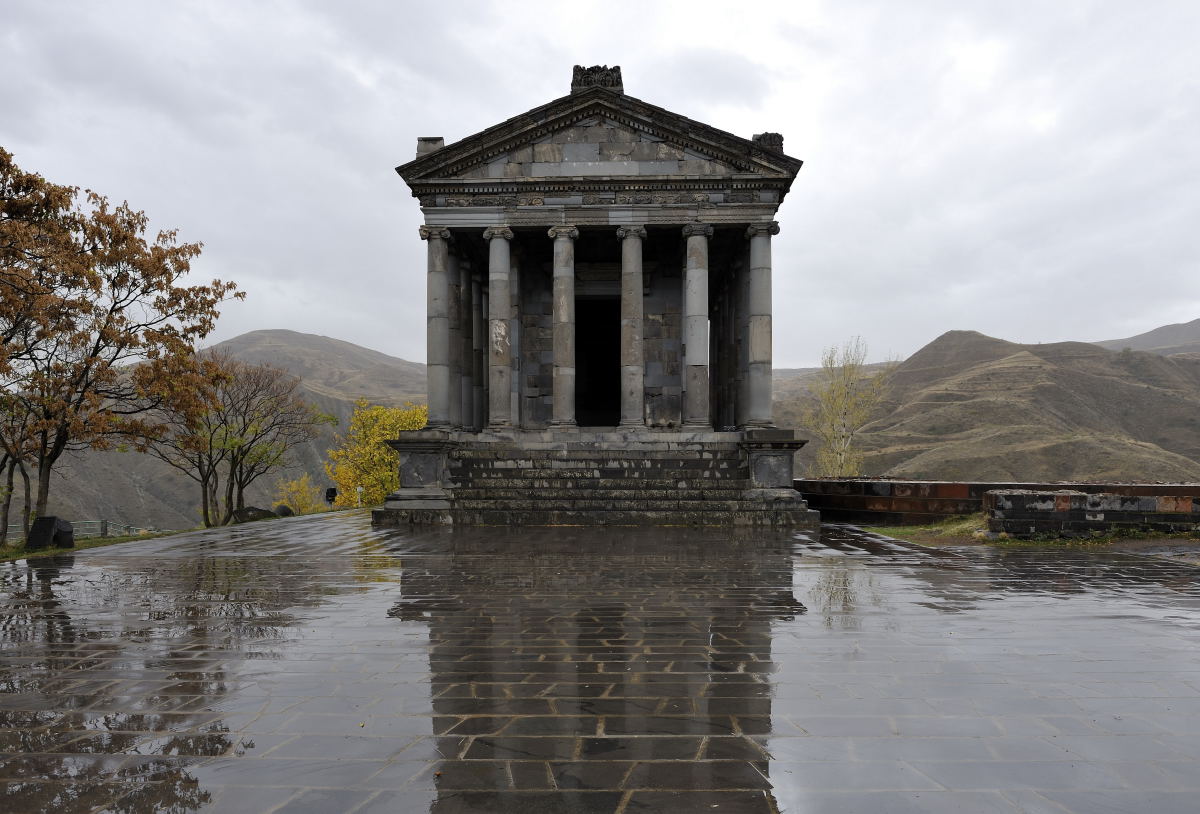 The Temple of Garni in Armenia. An example of Classical Armenian architecture of Hellenic inspiration, this Temple was first ordered to be built in dedication to Mithras by Tiridates I in approximately 66 CE. The god Mithras in time became merged with the Sol Invictus (Unconquered Sun) of the Roman Empire (Picture Source: Skyscraper City).
The Temple of Garni in Armenia. An example of Classical Armenian architecture of Hellenic inspiration, this Temple was first ordered to be built in dedication to Mithras by Tiridates I in approximately 66 CE. The god Mithras in time became merged with the Sol Invictus (Unconquered Sun) of the Roman Empire (Picture Source: Skyscraper City).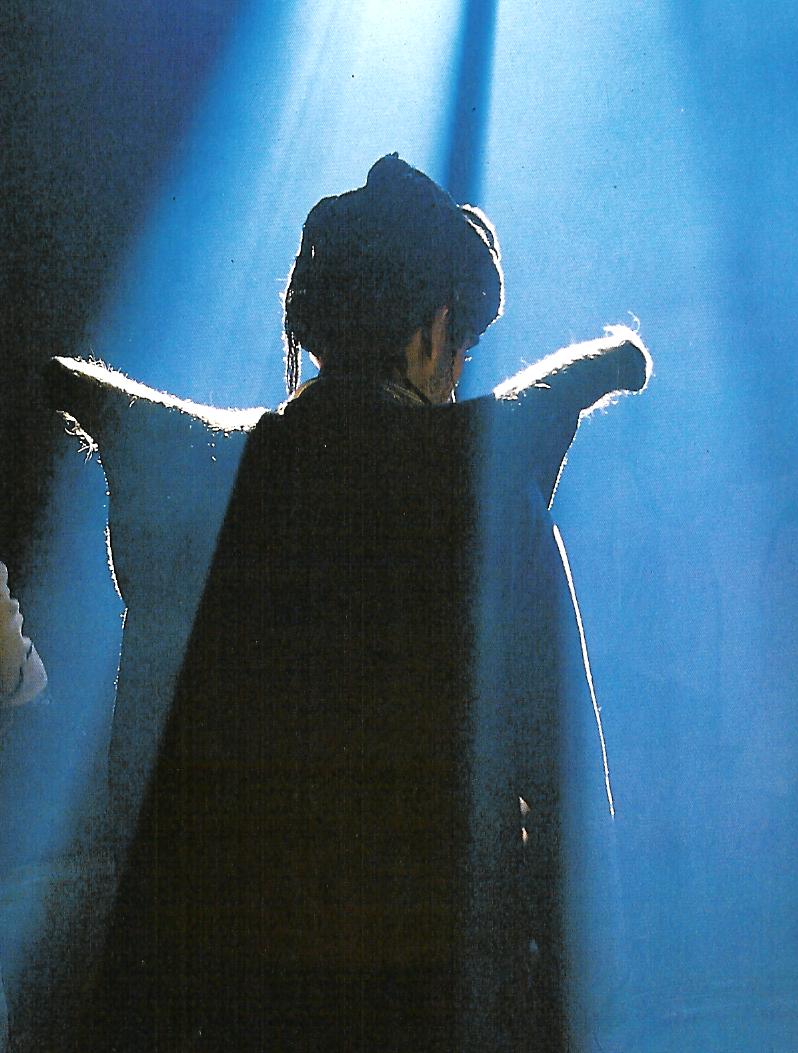 Kurdish man engaged in the worship of Mithras in a Pir’s (mystical leader/master) sanctuary which acts as a Mithraic temple (Courtesy Kasraian & Arshi, 1993, Plate 80). Note how he stands below an opening allowing for the “shining of the light”, almost exactly as seen with the statue in Ostia, Italy. These particular Kurds are said to pay homage to Mithras three times a day.
Kurdish man engaged in the worship of Mithras in a Pir’s (mystical leader/master) sanctuary which acts as a Mithraic temple (Courtesy Kasraian & Arshi, 1993, Plate 80). Note how he stands below an opening allowing for the “shining of the light”, almost exactly as seen with the statue in Ostia, Italy. These particular Kurds are said to pay homage to Mithras three times a day.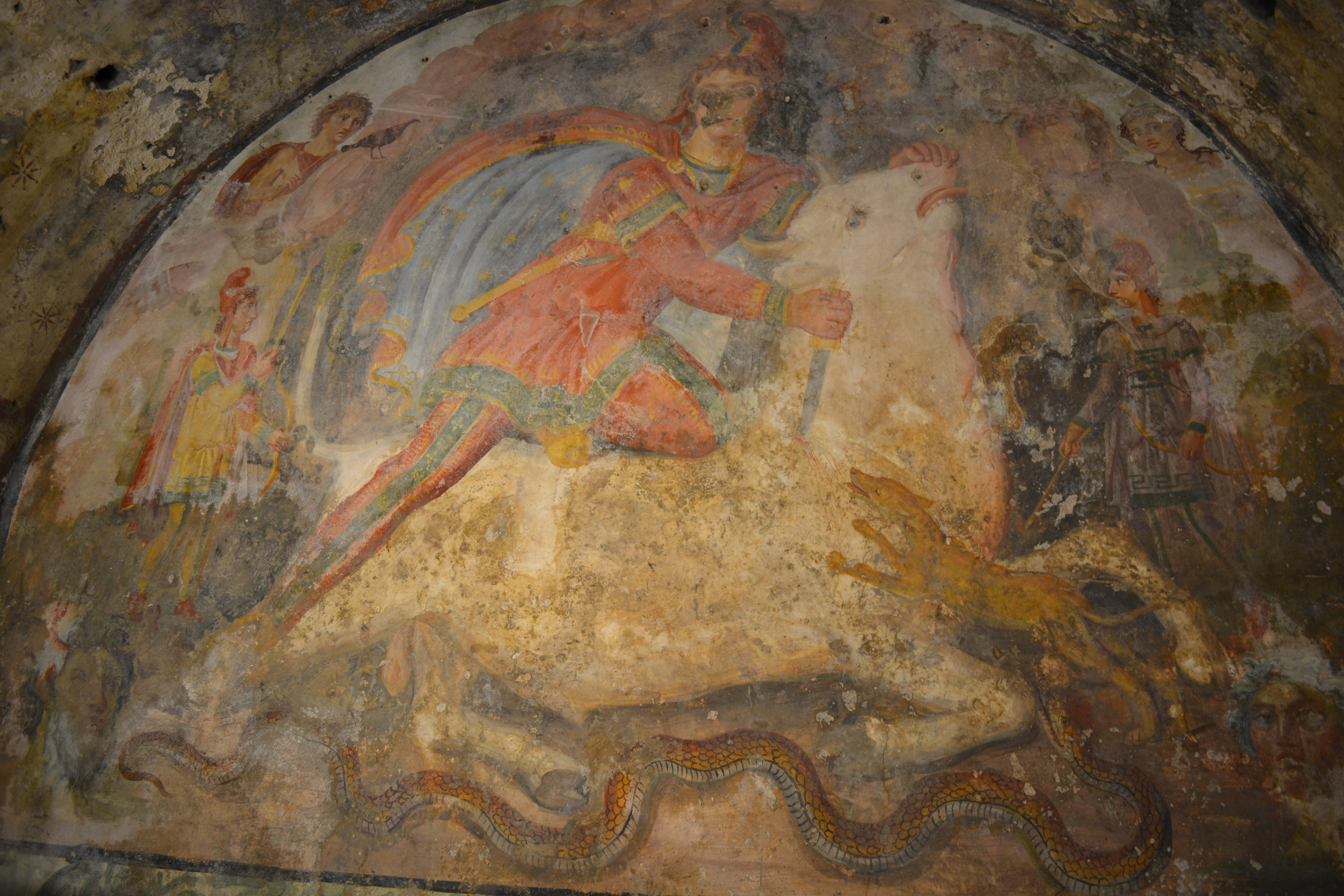 Depiction of Mithras with Persian dress of the Parthian and Early-Mid Sassanian era type, slaying the sacred bull at the Santa Maria Capua Vetere; Note the dog and serpent.
Depiction of Mithras with Persian dress of the Parthian and Early-Mid Sassanian era type, slaying the sacred bull at the Santa Maria Capua Vetere; Note the dog and serpent.
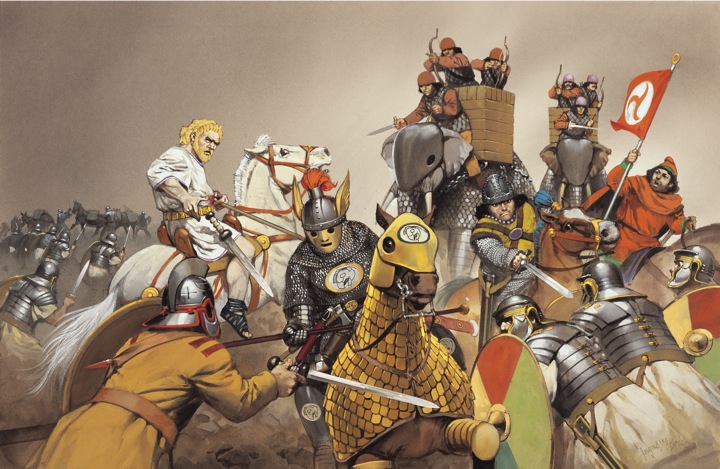
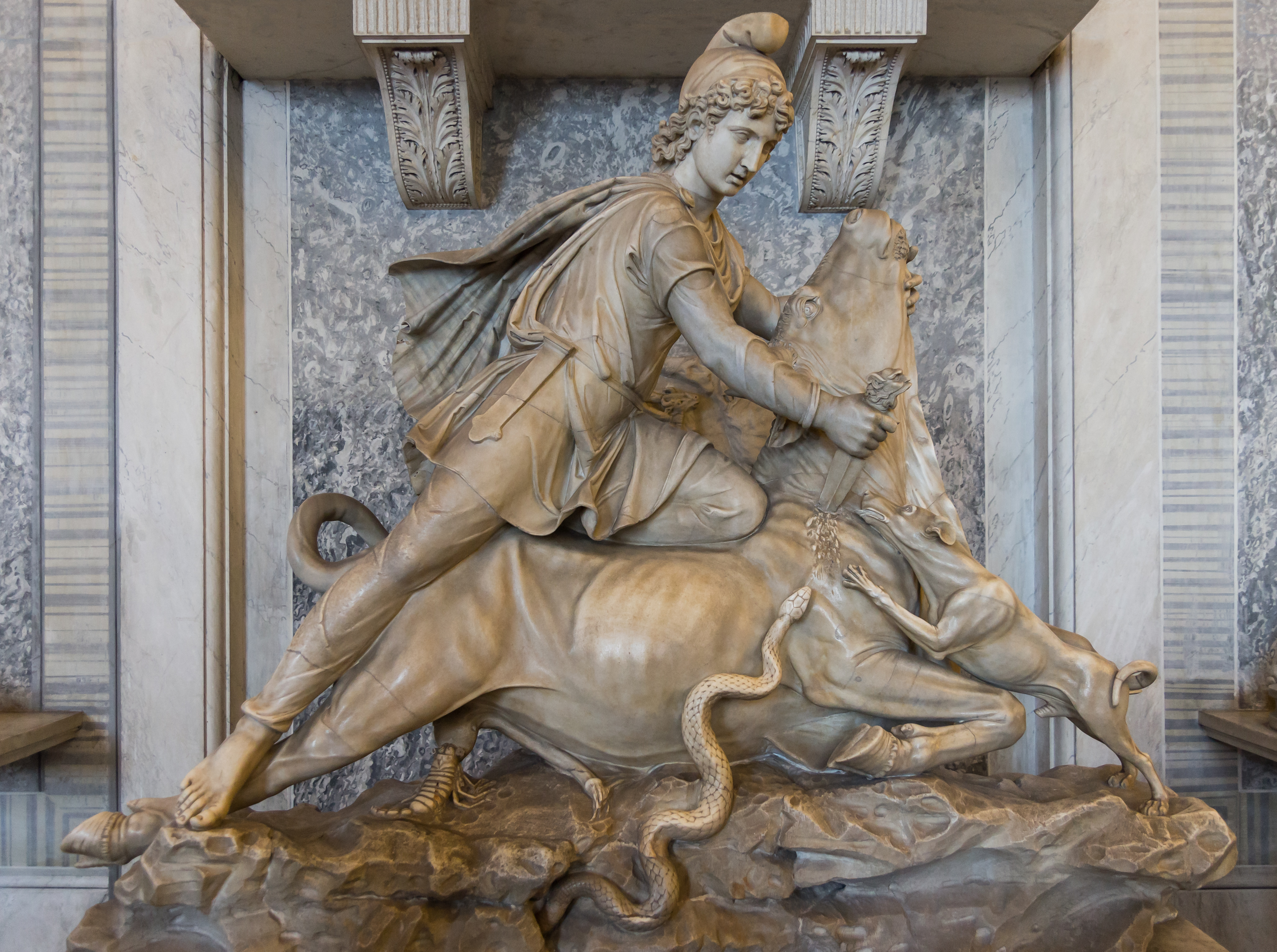 Another depiction of Mithras with Persian dress slaying the sacred bull at the Vatican Museum in Rome. Note the dog and serpent heading towards the gushing blood pouring down from the bull’s neck as the scorpion heads towards the dying bull’s testicles.
Another depiction of Mithras with Persian dress slaying the sacred bull at the Vatican Museum in Rome. Note the dog and serpent heading towards the gushing blood pouring down from the bull’s neck as the scorpion heads towards the dying bull’s testicles.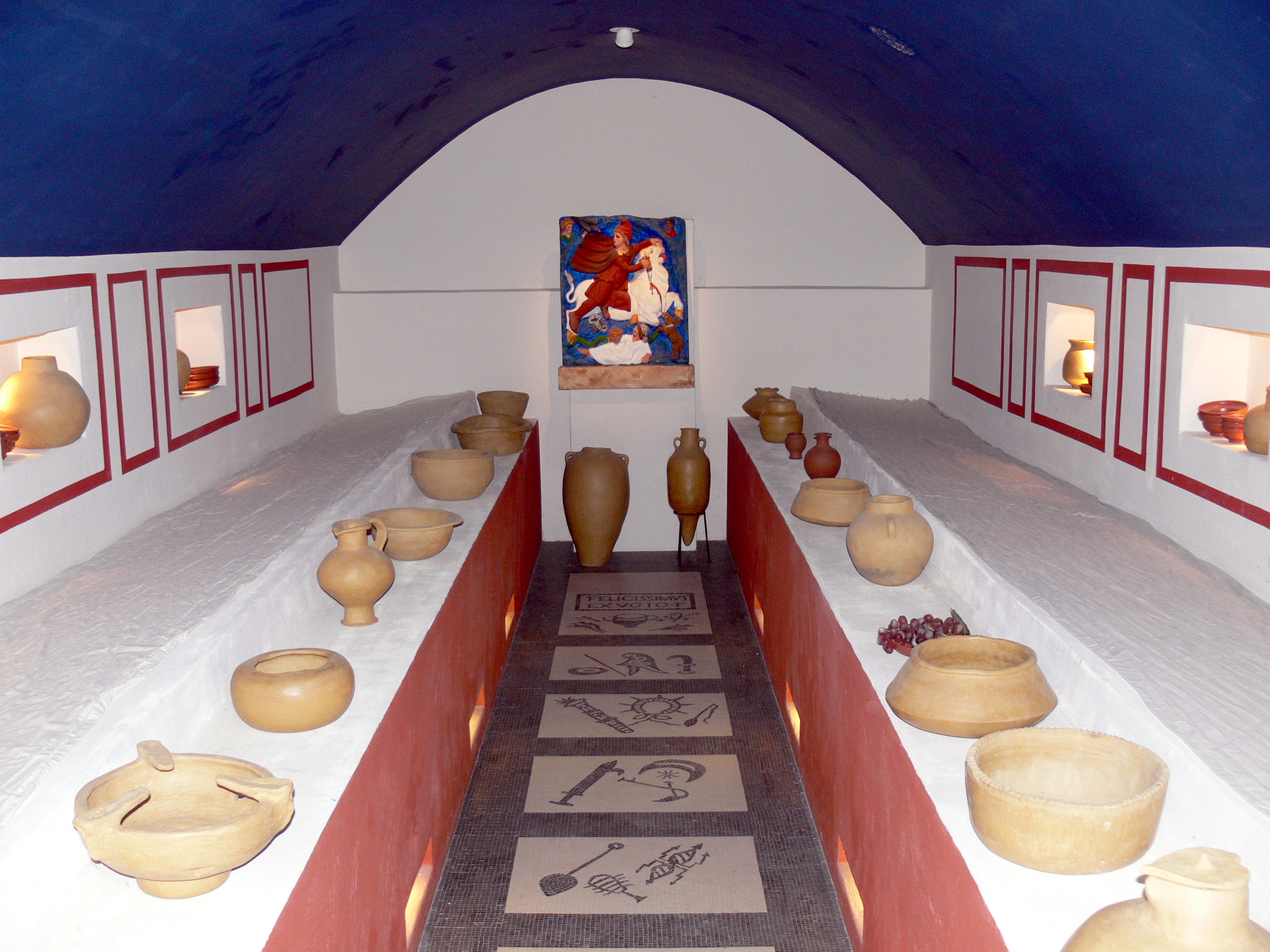 A reconstruction of a Mithraeum (Darb-e Mehr) depicting the stages of ascension on the floor as alluded to in an earlier figure in this posting. Note the placing of grapes (right side); grapes continue to signify vitality and renewal in Iran, Italy, Anatolia and the Caucasus.
A reconstruction of a Mithraeum (Darb-e Mehr) depicting the stages of ascension on the floor as alluded to in an earlier figure in this posting. Note the placing of grapes (right side); grapes continue to signify vitality and renewal in Iran, Italy, Anatolia and the Caucasus. 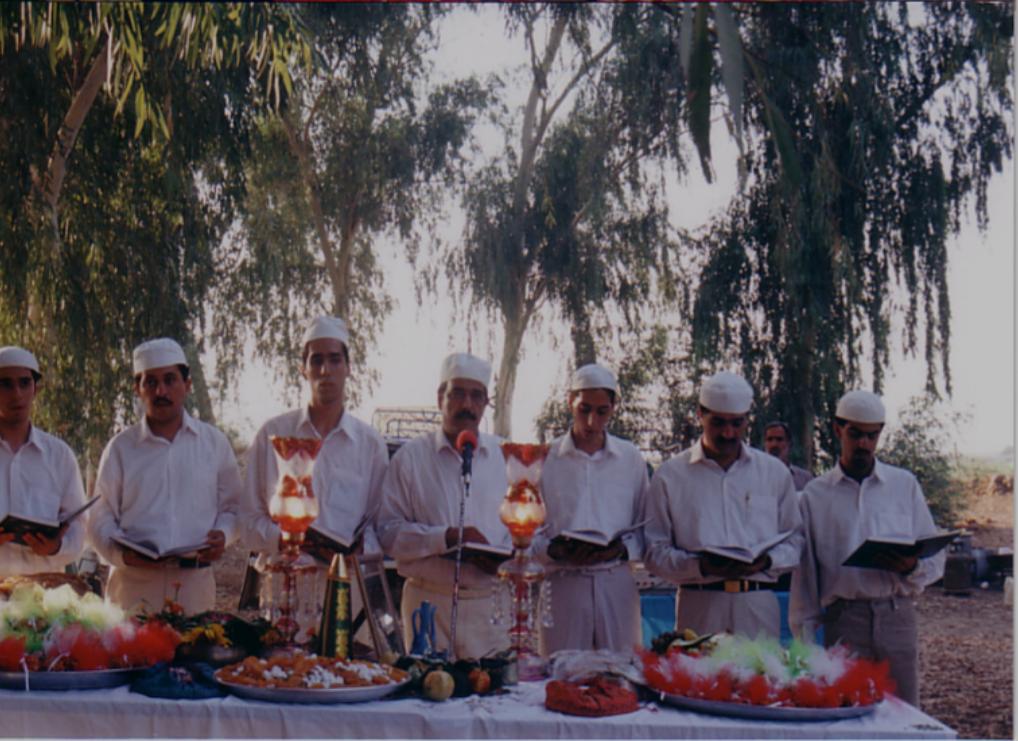 Zoroastrians engage in the celebration of Mehregan or festival of Mithras in Shushtar, Iran (Picture source: Kouroush Niknam). For more see article by Massoume Price entitled “Mehregan”…
Zoroastrians engage in the celebration of Mehregan or festival of Mithras in Shushtar, Iran (Picture source: Kouroush Niknam). For more see article by Massoume Price entitled “Mehregan”… The Mehregan Persian Music festival as reported in the North Shore News of North Vancouver (British Columbia, Canada) on October 17, 2003.
The Mehregan Persian Music festival as reported in the North Shore News of North Vancouver (British Columbia, Canada) on October 17, 2003.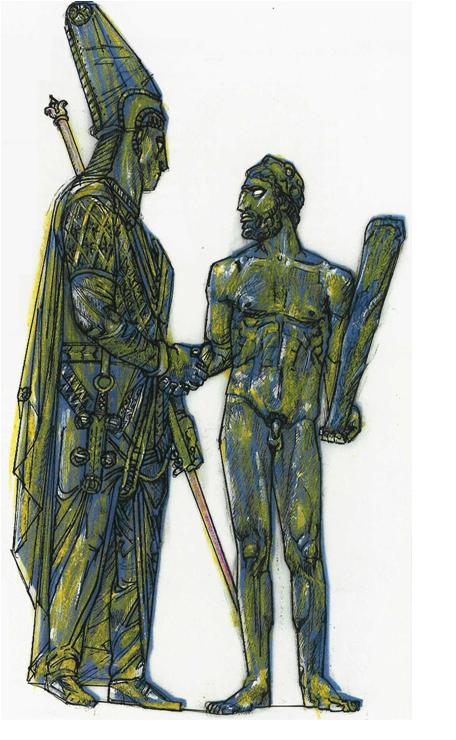 Nik Spatari’s drawing of the site of Eski Kale in Turkey (dated to circa 300 BCE) showing Mithras at left in Iranian attire shaking hands with the Hellenic God Zeus at right. This may be one of the first artistic depictions of the handshake symbolizing the “Payman” (pact).
Nik Spatari’s drawing of the site of Eski Kale in Turkey (dated to circa 300 BCE) showing Mithras at left in Iranian attire shaking hands with the Hellenic God Zeus at right. This may be one of the first artistic depictions of the handshake symbolizing the “Payman” (pact).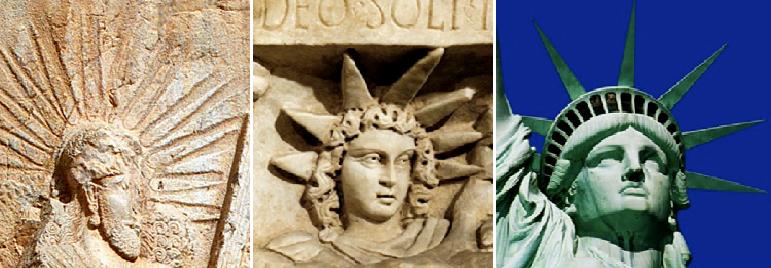 Mithras’ Enduring Legacy? (Left) Mithras at Taghe Bostan, Western Iran; (Middle) Deo Sol Invictus, Italy; (Right) The Statue of Liberty, Staten Island, New York.
Mithras’ Enduring Legacy? (Left) Mithras at Taghe Bostan, Western Iran; (Middle) Deo Sol Invictus, Italy; (Right) The Statue of Liberty, Staten Island, New York.



